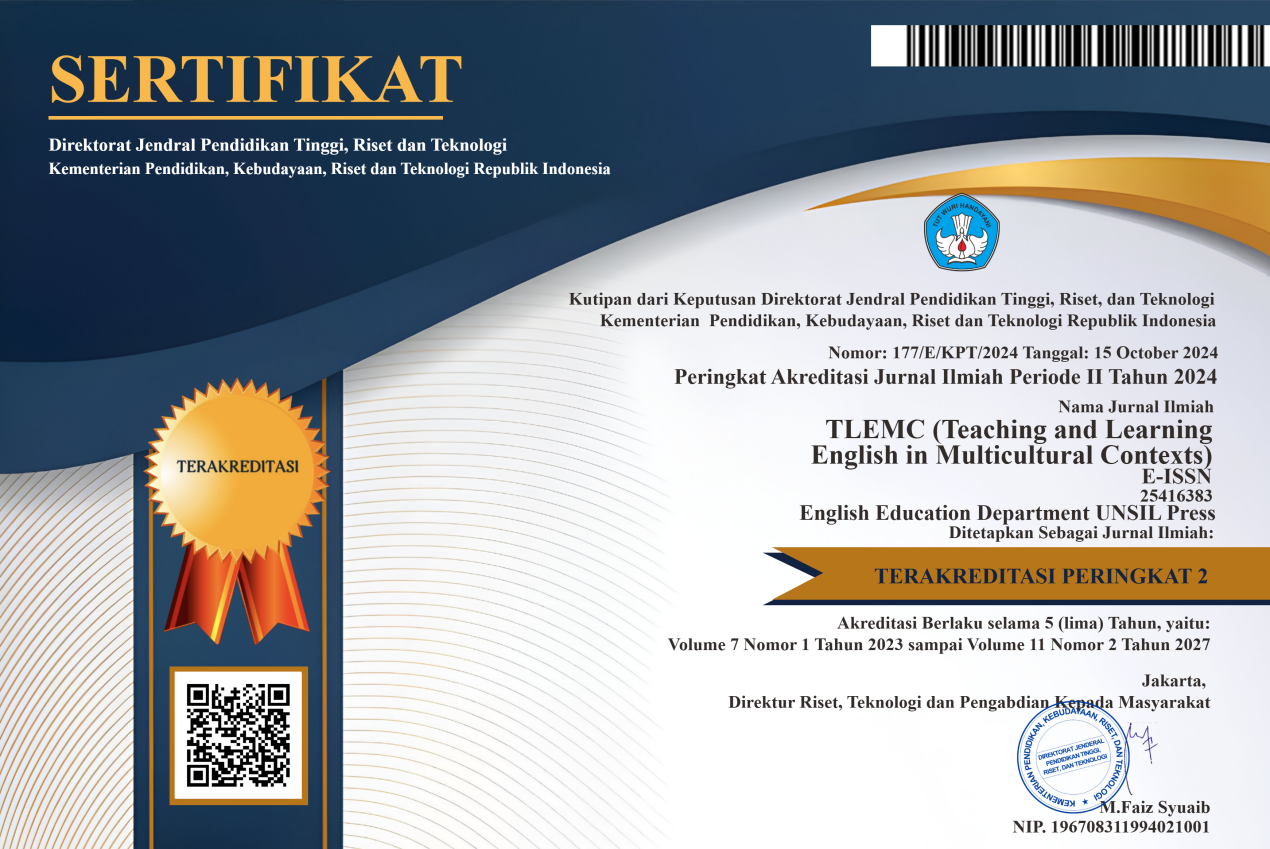Scrutinizing the Reasons for Using First Language in EFL Classrooms
Abstract
Using first language in the English class remains a controversial and an interesting issue to investigate, since it becomes an inevitable phenomenon especially in EFL contexts. Thus, this present study aims to investigate the underlying reasons for using L1 by both students and teacher in the EFL classrooms. In this case study, semi-structured interview was used to collect the data from the teacher and the students related to the reasons of using L1 in EFL classrooms. Thematic Analysis (Braun & Clarke, 2006) was used to analyze the data. The research results showed that the teachers generally used L1 because they believed that it supported the effective process of language teaching, since it can avoid students’ confusion over the materials being discussed, and it can make the students feel more comfortable in joining teaching and learning process. Meanwhile, the students used L1 mostly because of their natural habit, lack of confidence, and fear of making mistakes due to their low proficiency level in using English. Additionally, they also consider that using L1 was easier to communicate their ideas. In conclusion, L1 plays some supportive roles in English class. However, its use must be re-examined, since it should be used appropriately to achieve the better learning outcomes.
Full Text:
PDFReferences
Adnan, M.A.M., and Mohamad, S. (2014). “Teachers’ Attitudes Towards the use of First Language in Arabic Classroomâ€. International Refereed Research Journal ,V (2), 20-28.
Afzal, Shadi. (2013). “Using of The First Language in English Classroom as a Way of Scaffolding for Both the Students and Teachers to Learn and Teach Englishâ€. International Research Journal of Applied and Basic Sciences, 4 (7), 1846-1854.
Alshehri, E. (2017). Using Learners' First Language in EFL Classrooms. IAFOR Journal of Language Learning, 3(1), 20-33.
Atkinson, David. (1987). “A Neglected Resource?â€. ELT Journal 41 (4), 241-247.
Atkinson, David. (1993). Teaching Monolingual Classes. London: Longman.
Braun, V and Clarke, V.(2006). Using Thematic Analysis in Psychology. Qualitative Research in Psychology. 3(2). 77-101.Braun, V and Clarke, V.(2006). Using Thematic Analysis in Psychology. Qualitative Research in Psychology. 3(2). 77-101.
Broughton, G., Brumfit, C., Pincas, A., & Wilde, R. D. (2002). Teaching English as a foreign language. Routledge.
Brown, H. Douglas. (2007). Teaching by Principles. London and New York: Longman.
Cook, Vivian. (2001). “Using the First Language in the Classroomâ€. The Canadian Modern language Review. Vol. 57, Issue 3, 402-423.
Ellis, Rod. (1985). Understanding Second Language Acquisition. New York: OUP.
Halasa, Najwa Hanna and Al-Manaseer, Majeda. (2012). “The use of The First Language in Second Language Learning Recosideredâ€. College Students Journal, 46 (1), 71-81.
Harbord, John. (1992). “The use of Mother Tongue in the classroomâ€. ELT Journal, 46 (4), 350-355.
Harmer, Jeremy. (2001). The Practice of English Language Teaching. London: Longman.
Jan, C.W., Li, B.J. and Lin, C.C. (2014). “The use of Mother Tongue in Chinese EFL Classroomâ€. Journal of China University of Science and Technology, 58 (1), 161-181.
Karimian, Z., & Mohammadi, S. (2015). Teacher's use of first language in EFL classrooms. Journal of Applied Linguistics and Language Research, 2(3), 61-71.
Khati, Ashok Raj. (2011). “When and Why of Mother Tongue Use in English Classroomâ€. NELTA, 16 (1-2), 42-51.
Kim, Yuri and Petraki, Eleni. “Students’ and Teachers’ Use of and Attitudes to L1 in the EFL Classroomâ€. The Asian EFL journal Quarterly December 2009, 11 (4), 58-85.
Krashen, Stephen D. (1982). Principle and Practice of Second Language Acquisition. Oxford : Permagon.
Li, Jun. (2012). “Principles of Effective English Language Learner Pedagogyâ€. College Board Research Report, Research in Review, 2012-3, 1- 17.
Littlewood, William and Yu, Baohua. (2011). “First Language and Target Language in Foreign Language Classroomâ€. Language Teaching, 44 (1), 64-77.
Mart, Cagri Tugrul. (2013). “The Facilitating Role of L1 in ESL Classesâ€. International Journal of Academic Research in Business and Social Sciences, 3 (1), 9-14.
Mora Pablo, I., Lengeling, M. M., Rubio Zenil, B., Crawford, T., & Goodwin, D. (2011). Students and teachers' reasons for using the first language within the foreign language classroom (French and English) in Central Mexico. Profile Issues in Teachers Professional Development, 13(2), 113-129.
Nation, Paul. (2003). The Role of First Language in Foreign Language Learning. Retrieved from http://www. asian-efl-journal.com/june_2003pn.pdf.html.
Nazary, M. (2008). “The Role of L1 in L2 Acquisition : Attitudes of Iranian University Studentsâ€. NOVITAS- Royal, 2 (2), 138-153.
Scwheers, William C. (1999). “Using L1 in the L2 Classroomâ€. English Teaching Forum, 37 (2), 6-13.
Tang, J. (2002).â€Using L1 in the English Classroomâ€. English Teaching Forum, 40 (1), 34-36.
Turnbull, Miles and Dailey-O’Cain, Jennifer. (2009). First Language Use in Second and Foreign Language Learning. Great Britain : MPG Books Groups.
DOI: https://doi.org/10.37058/tlemc.v5i2.4310
Refbacks
- There are currently no refbacks.
INDEXED BY:
This work is licensed under a Creative Commons Attribution-NonCommercial-ShareAlike 4.0 International License.
![]()
TLEMC (Teaching and Learning English in Multicultural Contexts)
Program Studi Pendidikan Bahasa Inggris
Fakultas Keguruan dan Ilmu Pendidikan
Universitas Siliwangi
Jl. Siliwangi No. 24 Kota Tasikmalaya - 46115
email: tlemc@unsil.ac.id





